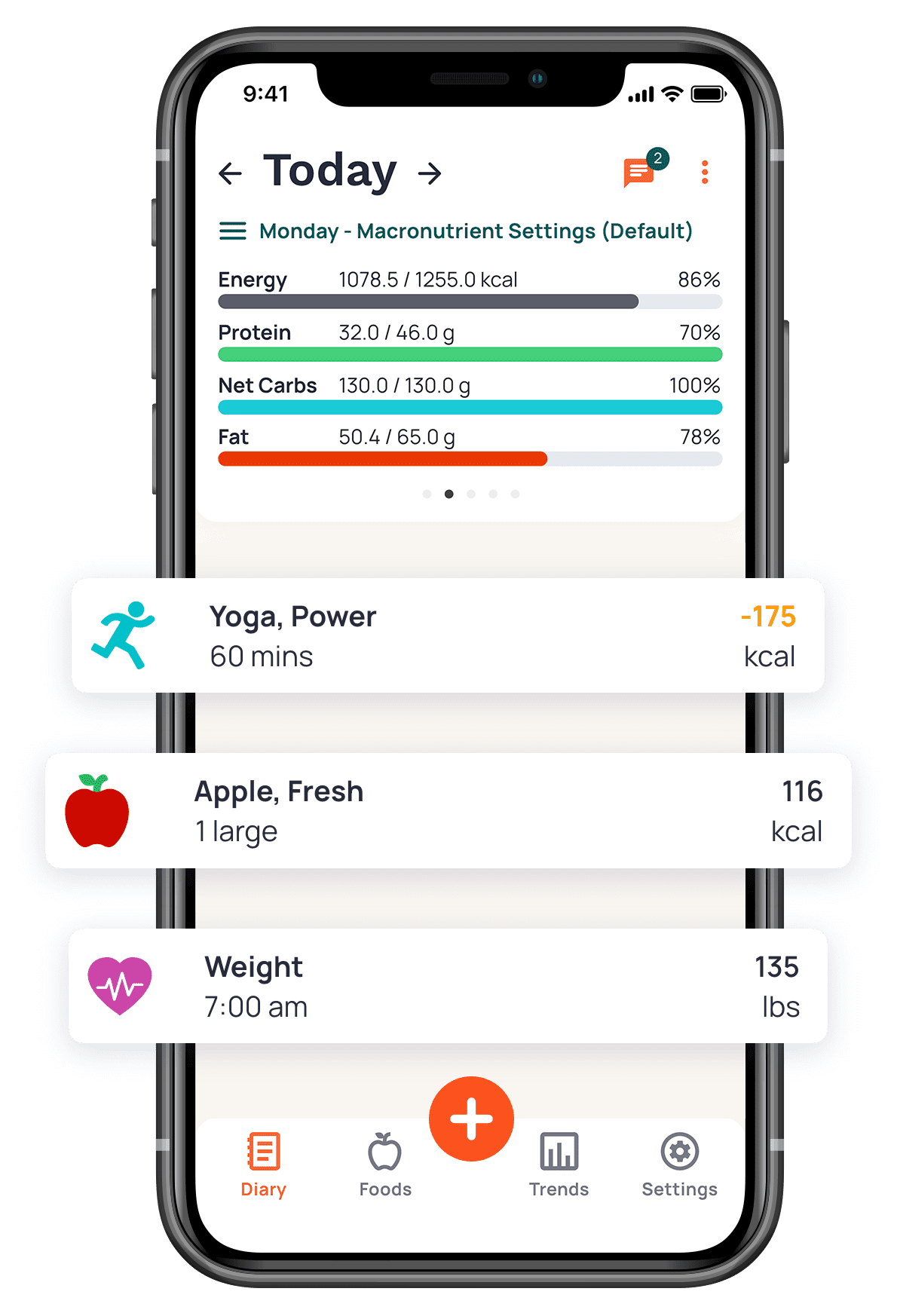Another guest post from Susan Macfarlane, a Registered Dietitian Nutritionist running a busy private practice in Canada’s capital of Ottawa, Ontario, explaining the benefits of the calcium and magnesium information you can get from Cronometer.
Included at the end are links to Susan’s previous article’s.
Calcium
What is calcium and why do I need it?
Calcium is an essential mineral well known for its role in bone health. About 99% of our body’s calcium is found in the bones and teeth where it maintains the structure of the skeletal system (1). The body’s remaining calcium is found in soft tissues and blood where it is regulated to keep calcium in a tight range. If blood calcium drops, the body will take calcium from the bones, which over time, leads to weakened bone mass (a risk factor for osteoporosis). Calcium in the blood has many roles, including muscle contraction, nerve impulse transmission, hormone secretion, and maintenance of healthy blood vessels and blood clotting (1).
Acute calcium deficiency is challenging to detect since blood calcium is maintained within a narrow concentration. Low blood calcium is only seen in diseases of the parathyroid gland, chronic kidney disease, alcoholism, or with deficiencies of vitamin D or magnesium (1).
How much calcium do I need each day?
Determining calcium requirements has been somewhat challenging since factors beyond calcium, such as vitamin D status, dietary pattern, and physical fitness, impact bone health. Specific targets for intake vary slightly by country, with some suggesting that current recommendations are in excess of needs (2). The World Health Organization has also suggested that calcium requirements for individuals consuming plant-based diets may be lower since less calcium is lost in the urine (an outcome seen with high intakes of animal-based protein; 3).
Nonetheless, it is likely best to err on the side of caution by meeting the RDA (Recommended Dietary Allowance) for calcium highlighted below:
| Age Group | RDA (mg/day) | UL (mg/day) | |
| Male | Female | ||
| 0-6 months | 200* | 200* | 1000 |
| 7-12 months | 260* | 260* | 1500 |
| 1-3 years | 700 | 700 | 2500 |
| 4-8 years | 1000 | 1000 | 2500 |
| 9-18 years | 1300 | 1300 | 3000 |
| 19-50 years | 1000 | 1000 | 2500 |
| 51-70 years | 1000 | 1200 | 2000 |
| 71+ | 1200 | 1200 | 2000 |
* Recommendation is an AI (Adequate Intake) For requirements needed in pregnancy/breastfeeding, please click here. Source: Institute of Medicine. Dietary Reference Intakes: The Essential Guide to Nutrient Requirements. Washington D.C.: The National Academies Press; 2006. Calcium; p 286-295. |
Nutrients that interact with calcium
Although protein can cause calcium losses in the urine, it also enhances calcium absorption (4). This finding has led researchers to encourage a moderate protein intake at the RDA. Other vitamins that interact with calcium include sodium (increases losses), potassium (reduces losses), and magnesium, which is discussed below. Excessive caffeine, oxalic acids – found in spinach, rhubarb, and sweet potatoes – along with phytic acid may also reduce the absorption of calcium (4).
How much calcium is too much?
The upper limit for calcium has been set at 2500 mg for healthy adults to prevent a condition known as ‘calcium-alkali syndrome’ (5). This condition is more commonly seen in chronic high-dose calcium supplementation and is characterized by high calcium in the blood and kidney failure (1).
What foods contain calcium?
| Plant-based | Plant Milks* | 1 cup | 321-324 |
| Tofu, Firm | ½ cup | 253 | |
| Blackstrap Molasses | 1 tbsp | 200 | |
| Almond Cashew Yogurt** | 125 g | 165 | |
| Beans (soy, pinto, navy, white, chickpeas, turtle) | 1 cup | 80-175 | |
| Bok Choy, cooked | 1 cup | 158 | |
| Tahini | 2 tbsp | 128 | |
| Almond Butter | 2 tbsp | 108 | |
| Kale, Cooked | 1 cup | 94 | |
| Tempeh, Firm | ½ cup | 92 | |
| Broccoli, Cooked | 1 cup | 62 | |
| Animal-based | Cheese | 50 g | 252-506 |
| Cow’s Milk | 1 cup | 291-322 | |
| Sardines | 2 ½ oz | 286 | |
| Salmon | 2 ½ oz | 179-212 | |
| Yogurt | ½ cup | 175-183 | |
| Cottage Cheese | ½ cup | 73-133 | |
*Check the label as not all plant-milks are fortified **Packaging information Source: Dietitians of Canada. Food sources of calcium. 2016. Available here. ; Physicians Committee for Responsible Medicine. Calcium in Plant-Based Diets. n.d. Available here. Values for calcium are shown in mg. | |||
Calcium and Disease
Cancer
A growing body of research has emerged raising concern about the link between dairy products and prostate cancer (1). The results of a 2015 systematic review and meta-analysis showed that high intakes of dairy, total milk, whole milk, low-fat milk, cheese, and dairy calcium was associated with a modest, but significant risk of prostate cancer (5). This study did not find an association between plant-based milks or calcium supplements and the risk for prostate cancer (5).
The association between dairy products, calcium supplementation, and colorectal cancer is not as clear, with some studies showing a benefit of dairy products or calcium supplementation (6-8), with others failing to find any association (9,10).
Cardiovascular Disease
Earlier studies have raised concerns that calcium supplements increase the risk of cardiovascular disease. However, the results of a recent systematic review and meta analysis concluded that calcium intakes that did not exceed the upper limit for calcium, from either supplements or food, were not associated with an increased risk of cardiovascular disease (11). Regardless, it may be wise to err on the side of caution, aiming for an intake that meets, but doe not exceed the RDA for calcium, until more research becomes available.
Magnesium
What is magnesium and why do I need it?
Magnesium is involved in more than 300 reactions in the body, assisting in the release of energy from fat and carbohydrates, helping with DNA production, supporting nerve impulses, muscle contractions, as well as normal heart rhythms, facilitating cellular communication, and providing structure to bones and body tissues (12).
Estimates suggest that almost half of the US population is not meeting recommended requirements[i] for magnesium, with the lowest levels of intake being found among the elderly (13). Older adults are believed to be disproportionately affected due to low dietary intake of magnesium, reduced absorption, and increased urinary losses (12).
Overt magnesium deficiency is rare in developed countries, but is more commonly seen in specific conditions, including gastrointestinal disorders, renal disease, diabetes, and alcoholism (12). When magnesium deficiency has been experimentally induced in humans, tremor, muscle spasms, loss of appetite, nausea, vomiting, and personality changes occurred (12). In addition, magnesium deficiency also disrupts calcium balance, which can exaggerate vitamin D deficiency (12).
How much magnesium do I need each day?
Magnesium requirements that will meet ~98% of a healthy population for various age groups can be viewed below. Requirements for adults and children were set following balance studies that aimed to match intake to losses (14).
| Age Group | RDA (mg/day) | UL (mg/day) | |
| Male | Female | ||
| 0-6 months | 30* | 30* | Unknown |
| 7-12 months | 75* | 75* | Unknown |
| 1-3 years | 80 | 80 | 65 |
| 4-8 years | 130 | 130 | 110 |
| 9-13 years | 240 | 240 | 350 |
| 14-18 years | 410 | 360 | 350 |
| 19-30 years | 400 | 310 | 350 |
| 31-70+ | 420 | 320 | 350 |
* Recommendation is an AI (Adequate Intake) For requirements needed in pregnancy/breastfeeding, please click here. Source: Institute of Medicine. Dietary Reference Intakes: The Essential Guide to Nutrient Requirements. Washington D.C.: The National Academies Press; 2006. Magnesium; p 340-349. | |||
Nutrients that interact with magnesium
Like calcium, many nutrients and food components can interfere with magnesium. Phytic acid found in raw beans, seeds, nuts and grains, as well as excessive intake of calcium (>2600 mg) and phosphorus can decrease absorption of magnesium. In addition, magnesium status is impacted by too little or too much protein, warranting intake around the RDA (14).
How much magnesium is too much?
The upper limit for magnesium applies to supplements only and has been set at 350 mg per day for individuals aged 9 years and older (14). Since magnesium is a natural laxative, intakes above this amount can cause diarrhea (12). Individuals with renal disease are more likely to experience magnesium toxicity and should avoid supplementation, unless approved by their medical doctor (12).
What foods contain magnesium?
Plant-based foods, especially seeds, nuts, beans, and wheat bran, are the best sources of magnesium.
| Pumpkin seeds | ¼ cup | 317 |
| Black-eyed peas | ¾ cup | 121 |
| Tempeh | ¾ cup | 116 |
| Sunflower seeds | ¼ cup | 115 |
| Flaxseeds | 2 tbsp | 111 |
| Soybeans | ¾ cup | 109 |
| Almonds | ¼ cup | 88-109 |
| All Bran Cereals | 30 g | 85-97 |
| Wheat germ | ¼ cup | 96 |
Source: Source: Dietitians of Canada. Food sources of calcium. 2016. Available here. Values for magnesium are shown in mg. | ||
Magnesium and disease
Magnesium deficiency has been implicated in several chronic diseases, including hypertension, type 2 diabetes, and cardiovascular disease. The results of a meta-analysis showed that supplemental magnesium helped reduce blood pressure in individuals with hypertension (15). In addition, magnesium, along with dietary fibre and potassium, is a key component of the DASH diet; a dietary pattern shown to effectively reduce blood pressure (16).
Several meta-analyses have also found an inverse relationship between magnesium intake and the risk of developing type 2 diabetes (17-19), while the risk of having a cardiovascular event (including stroke, heart attack, and coronary heart disease) was found to be 15% lower among individuals with a higher intake of magnesium (20).
What is the ideal ratio of calcium to magnesium?
The relationship between calcium and magnesium is complex, interdependent, and not fully understood. Studies have shown that high intakes of calcium may interfere with magnesium status by reducing intestinal absorption and increasing urinary losses (21). Additionally, magnesium deficiency is known to induce calcium deficiency in experimental conditions (12). A ratio of 2:1 for calcium to magnesium has been recommended, despite a lack of research supporting this recommendation (21). Until more research is published on the ideal ratio of calcium to magnesium, the best approach is to meet minimum targets for magnesium, while ensuring a calcium intake at, but not above, the RDA.
References
- Linus Pauling Institute. Calcium. 2017. Available here.
- Harvard Health Publishing. How much calcium do you really need? 2017. Available here.
- Food and Agriculture Organization of the United Nations (FAO). Chapter 11: Calcium. 2001. Available here.
- Institute of Medicine. Dietary Reference Intakes: The Essential Guide to Nutrient Requirements. Washington D.C.: The National Academies Press; 2006 (updated 2011). Overview of Calcium; p 35-74.
- Aune D, Navarro Rosenblatt DA, Chan DS, Vieira AR, Vieira R, Greenwood DC, et al. Dairy products calcium, and prostate cancer risk: a systematic review and meta-analysis of cohort studies. Am J Clin Nutr, 2015 Jan;101(1):87-117. Abstract available here.
- Murphy N, Norat T, Ferrari P, et al. Consumption of dairy products and colorectal cancer in the European Prospective Investigation into Cancer and Nutrition (EPIC). PLoS One. 2013;8(9):e72715. Abstract available here.
- Massa J, Cho E, Orav EJ, Willett WC, Wu K, Giovannucci EL. Total calcium intake and colorectal adenoma in young women. Cancer Causes Control. 2014;25(4):451-460. Abstract available here.
- Bonovas S, Fiorino G, Lytras T, Malesci A, Danese S. Calcium supplementation for the prevention of colorectal adenomas: A systematic review and meta-analysis of randomized controlled trials. World J Gastroenterol. 2016;22(18):4594-4603. Abstract available here.
- Bristow SM, Bolland MJ, MacLennan GS, et al. Calcium supplements and cancer risk: a meta-analysis of randomised controlled trials. Br J Nutr. 2013;110(8):1384-1393. Abstract available here.
- Bolland MJ, Grey A, Gamble GD, Reid IR. Calcium and vitamin D supplements and health outcomes: a reanalysis of the Women’s Health Initiative (WHI) limited-access data set. Am J Clin Nutr. 2011;94(4):1144-1149. Abstract available here.
- Chung M, Tang AM, Fu Z, Wang DD, Newberry SJ. Calcium intake and cardiovascular disease risk: an updated systematic review and meta-analysis. Ann Intern Med. 2016 Dec; 165(12):856-866. Abstract available here.
- Linus Pauling Institute. Magnesium. 2014. Available here.
- Navarro-Gonzalez JF, Mora-Fernandez C, Garcia-Perez J. Clinical implications of disordered magnesium homeostasis in chronic renal failure and dialysis. Semin Dial. 2009;22(1):37-44. Abstract available here.
- Institute of Medicine. Dietary Reference Intakes: The Essential Guide to Nutrient Requirements. Washington D.C.: The National Academies Press; 2006. Magnesium; p 340-349.
- Kass L, Weekes J, Carpenter L. Effect of magnesium supplementation on blood pressure: a meta-analysis. Eur J Clin Nutr. 2012;66(4):411-418. Abstract available here.
- Saneei P, Salehi-Abargouei A, Exmaillzadeh A, Azadbakht L. Influence of Dietary Approaches to Stop Hypertension (DASH) diet on blood pressure: a systematic review and meta-analysis on randomized controlled trials. Nutr Metab Cardiovasc Dis. 2014 Dec;24(12):1253-61. Abstract available here.
- Schulze MB, Schulz M, Heidemann C, Schienkiewitz A, Hoffmann K, Boeing H. Fiber and magnesium intake and incidence of type 2 diabetes: a prospective study and meta-analysis. Arch Intern Med. 2007;167(9):956-965. Abstract available here.
- Larsson SC, Wolk A. Magnesium intake and risk of type 2 diabetes: a meta-analysis. J Intern Med. 2007;262(2):208-214. Abstract available here.
- Dong JY, Xun P, He K, Qin LQ. Magnesium intake and risk of type 2 diabetes: meta-analysis of prospective cohort studies. Diabetes Care. 2011;34(9):2116-2122. Abstract available here.
- Qu X, Jin F, Hao Y, et al. Magnesium and the risk of cardiovascular events: a meta-analysis of prospective cohort studies. PLoS One. 2013;8(3):e57720. Abstract available here.
- Rosanoff A, Dai Q, Shapses SA. Essential nutrient interactions: Does low or suboptimal magnesium status interact with vitamin D and/or calcium status? Adv Nutr. 2016 Jan;7(1):25-43. Abstract available here.
Rosanoff A. The 2-to-1 Calcium-to-Magnesium Ratio. (n.d.). PDF. Available here.
[i] Population reference is the EAR or Estimated Average Requirement
Links to Susan’s previous cronometer.com blog posts:
Building a Healthy Baby
Understanding Cronometer’s Nutrient Ratios – Zinc/Copper
Understanding Cronometer’s Nutrient Ratios – Omega 6 and 3







